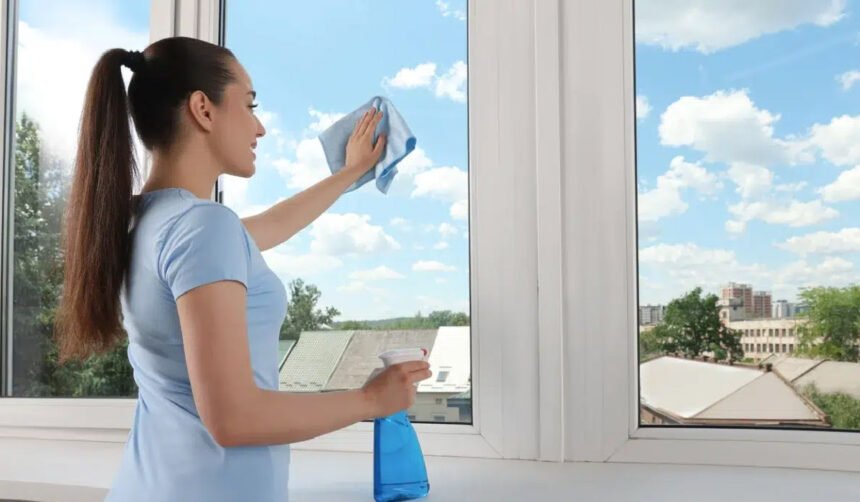Introduction
Windows serve as both aesthetic and functional elements in any space. They allow natural light to flood interiors, offer views of the outside world, and contribute to the overall energy efficiency of a building. However, when left uncleaned, they can quickly become dull, streaky, and even a source of indoor pollutants. That’s where window cleaning becomes more than just a chore—it becomes a necessity for comfort, health, and clarity.
Clean windows enhance more than just curb appeal. They create an environment that feels more open, refreshed, and inviting. In both homes and commercial spaces, this translates into better moods, higher productivity, and an improved perception of the property.
This comprehensive guide dives deep into the techniques, tools, timing, and long-term strategies for maintaining spotless windows all year round. Whether you’re doing it yourself or considering hiring a professional, these insights will help you elevate your window care routine.
Why Clean Windows Matter More Than You Think
While cleaning floors and surfaces is part of most people’s regular routines, windows often get neglected—despite being one of the first features people notice in a room.
1. Enhanced Natural Light
Dirty windows block and diffuse light unevenly, reducing the brightness of a room. Clean panes allow maximum light to pass through, making your space appear larger and more vibrant.
2. Better Indoor Air Quality
Window sills, frames, and glass surfaces can collect dust, pollen, mold spores, and other allergens. Regular cleaning minimizes these pollutants and contributes to a healthier indoor environment.
3. Longer Lifespan of Windows
Mineral deposits, acid rain, and airborne contaminants can etch or corrode glass over time. Regular window cleaning prevents long-term damage and saves you money on repairs or replacements.
4. Improved Energy Efficiency
Smudged and dirty windows reflect and absorb light unevenly. Clean windows help maintain consistent indoor temperatures by allowing sunlight to regulate warmth more effectively.
Tools of the Trade: What You Need for Effective Cleaning
While you can get by with basic household items, using the right tools makes the job easier and the results more professional.
Must-Have Tools:
- Squeegees: For streak-free drying and even solution distribution
- Microfiber cloths: Lint-free, absorbent, and ideal for detailing
- Buckets: To hold water or cleaning solution
- Spray bottles: For easy application of your cleaner
- Scrubbers or sponges: To break up grime before rinsing
- Extension poles: For reaching higher panes without a ladder
- Drop cloths or towels: To protect floors and catch drips
Optional but helpful:
- Razor blades or scrapers (for removing paint or adhesives)
- Vacuum with brush attachments (for window sills and tracks)
Choosing the Right Window Cleaning Solution
The market is full of commercial glass cleaners, but homemade options can be just as effective—and often more affordable and eco-friendly.
DIY Window Cleaning Solution:
- 1 part white vinegar
- 1 part water
- Optional: a few drops of dish soap (to break down oily grime)
- Mix in a spray bottle and shake before use
This solution cuts through grease, smoke residue, and fingerprints without leaving harmful residues behind.
The Step-by-Step Process to Perfectly Clean Windows
A systematic approach ensures consistent, streak-free results every time.
Step 1: Preparation
- Remove curtains, blinds, or other window coverings.
- Lay down towels or cloths to protect nearby surfaces and flooring.
- Vacuum or brush the window sills and frames.
Step 2: Dust and Dry Wipe
- Wipe down the glass with a dry microfiber cloth to remove loose dust and particles before applying liquid cleaner.
Step 3: Apply Cleaner
- Spray your chosen cleaning solution generously onto the glass surface.
- Let it sit for a few seconds to loosen dirt and grime.
Step 4: Scrub and Squeegee
- Use a scrubber or sponge to clean the surface in overlapping motions.
- Follow with a squeegee, starting from the top and pulling downward in straight strokes. Wipe the squeegee blade after each pass.
Step 5: Dry and Detail
- Use a dry microfiber cloth to clean the corners and edges.
- Inspect for any streaks or missed spots.
How Often Should You Clean Your Windows?
The ideal frequency depends on the type of building, local environment, and usage patterns.
For Homes:
- Interior: Every 2–3 months
- Exterior: Every 3–6 months, or more frequently if exposed to dust, salt, or rain
For Offices or Commercial Spaces:
- High-traffic areas: Monthly or even weekly
- Low-traffic or decorative windows: Every 2–4 months
Seasonal deep cleans are also highly effective—especially in spring and fall, when changes in weather and pollen levels are most pronounced.
Avoiding Common Window Cleaning Mistakes
Even well-intentioned cleaners can make mistakes that lead to streaks, scratches, or missed spots.
Mistake 1: Cleaning in Direct Sunlight
The sun causes the cleaning solution to dry too quickly, leading to streaks and uneven results.
Mistake 2: Using Paper Towels
While convenient, paper towels leave behind lint and can cause micro-scratches on some glass surfaces.
Mistake 3: Overusing Cleaner
Excessive product can leave a cloudy film if not properly rinsed or wiped off.
Mistake 4: Ignoring the Frames
Frames and tracks collect dust and moisture, leading to mold growth and potential window function issues.
Special Techniques for Different Window Types
Not all windows are the same, and specific types require tailored cleaning methods.
Double-Pane Windows
Check for fogging between the panes—this suggests a seal failure that cleaning alone can’t fix.
Tinted or Coated Windows
Use ammonia-free products to preserve the tint and coating. Always read manufacturer guidelines.
Skylights and Hard-to-Reach Windows
Use telescoping tools or hire professionals to ensure safety and effectiveness.
Decorative or Etched Glass
Avoid abrasive materials and opt for soft cloths and gentle cleaners.
When to Hire a Professional
While many people can handle basic window cleaning, certain situations call for expert help.
- Tall buildings or multi-story homes
- Severely stained or mineral-damaged glass
- Large commercial properties
- Time-sensitive cleaning needs
Professionals bring industry-grade equipment, insurance, and experience. In some cases, outsourcing can save time and deliver superior results.
If you’re managing a business or have windows in hard-to-access locations, hiring a service that specializes in window cleaning can ensure both safety and thoroughness.
Eco-Friendly Practices in Window Maintenance
As environmental awareness grows, many are turning to green cleaning methods.
Sustainable Tips:
- Use reusable microfiber cloths instead of disposable wipes
- Avoid harsh chemicals that release volatile organic compounds (VOCs)
- Choose non-toxic, biodegradable cleaners
- Limit water waste by using targeted spray bottles instead of open buckets
Eco-friendly practices are better for your health, the planet, and often your budget.
Extra Tips for Long-Term Maintenance
Keeping your windows in top shape doesn’t stop after one clean. Integrating regular habits will reduce buildup and make each cleaning session easier.
- Dust blinds and nearby surfaces regularly to prevent debris transfer
- Check caulking and seals to prevent moisture intrusion
- Install weather stripping to reduce dirt buildup from drafts
- Maintain landscaping to reduce exposure to pollen and leaves
Being proactive can make your window cleaning routine simpler, faster, and more effective over time.
Conclusion
Clean windows offer far more than just a polished look—they improve lighting, support mental well-being, and enhance your space’s functionality. With the right tools, techniques, and schedule, maintaining clean windows can be both simple and rewarding.
Whether you’re managing a home or business, developing a thoughtful cleaning routine ensures that your environment remains bright, healthy, and inviting. And for those moments when time, tools, or tall windows become a challenge, remember there are professionals trained specifically in window cleaning who can step in and do the job right.
The clarity you gain through clean windows is more than visual—it’s mental, emotional, and even environmental. Embrace the practice, and your space will reflect it—literally and figuratively.
For More Information, Visit Dotmagazine








